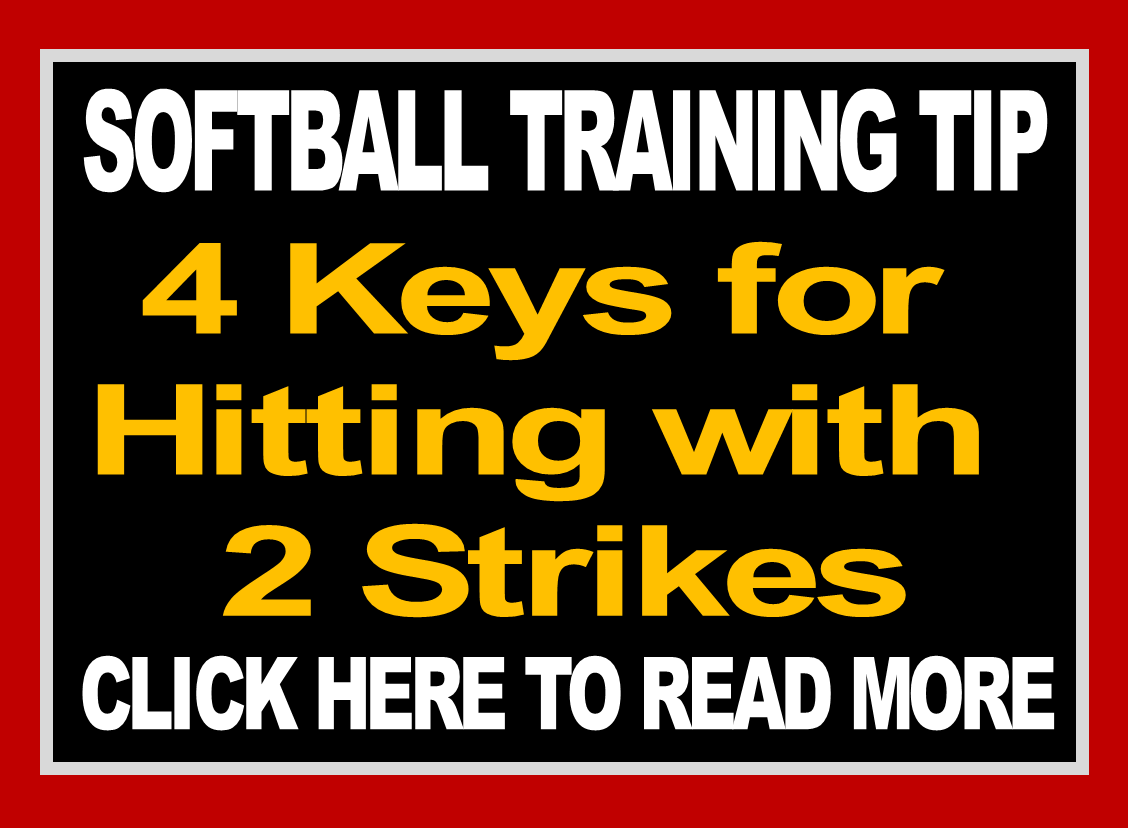
31 Jul 4 Keys for Hitting with 2 Strikes

Do your hitters bear down, or do they tense up, when they are faced with a 2-strike count?
Either way, make sure you know the 4 Keys to helping your players hit with 2 strikes.
You may not have thought about it but an at-bat actually has two parts; the first part occurs early in the count when the batter has less than 2 strikes, and the second part happens once she gets 2 strikes. Not that this is scientific or anything, it’s based on my own personal observation and experience, but I feel it’s important for us to know this in order to properly help our players succeed during both phases of an at-bat.
Early in the count, before the batter gets 2 strikes, the hitter is usually aggressive, and as Patrick Murphy from Alabama says, is trying to “crush the fatty!” This aggressive mind-set makes sense as it’s easier to be aggressive when you have less than 2 strikes. During this phase the hitter is also more selective, no doubt laying off pitches out of their smash zone and staying away from pitches on the edge. Hitters that are “up in the count” or “hitting positive” which are ways this part of an at-bat is often referred to, are able to be selective and aggressive since they are usually ahead or at least neutral in the count.
But once the batter gets 2 strikes things change, and usually not for the good. In most cases the batter goes from being aggressive and trying to smash the ball to suddenly trying “not to strike out”. This simple change in approach puts the pitcher in charge in an already pitcher-in-charge situation – which is why it often doesn’t end well for batters. True, with 2 strikes the pitcher does have an advantage over the batter, but that doesn’t mean the batter is finished. The pitcher must still get the batter out so the batter has to do everything possible to make that as hard as possible for the pitcher. Extend the at-bat, that’s your goal with 2 strikes.
While the first part of the at-bat is all about “Crushing The Fatty”, the goal of the second part is to “Put Your Fight On”! Fight off pitches, fight to get a walk, fight to put your bat on the ball….FIGHT! The batter can’t go from attacking pitches early in the count to trying NOT to strike out, and expect to beat a pitcher. No way, not with that type of limited approach. Since the hitter has an aggressive approach early in the count she needs to keep an aggressive approach later in the count, but in a way that helps her now that she has 2 strikes. Going crazy and swinging at everything would be considered aggressive, but wouldn’t fall into the smart category. Instead, having your hitter fight and battle to extend her at-bat is an aggressive mind-set that has a measure of control to it.
To help your hitters Fight with 2 strikes, have them follow this simple phrase: IN, UP, GO BIG! Basically, here’s what that means:
- IN: Hitters want to make it as hard as possible for the pitcher and to do that they can move IN on the plate and help shrink the pitcher’s strike zone. Moving closer to the plate helps take away the inside corner while making it easier for the batter to reach the outside. Simply moving an inch or 2 closer to the plate will help a batter Fight with 2 strikes.
- UP: Up refers to choking up, not moving up. Some people will have their hitters move up in the box with 2 strikes but I’ve never done that. Hitters get comfortable hitting from one spot in the batters box and when we change that by asking them to move up in the box, not only does it put them in an unfamiliar situation, but it also can play havoc with their confidence. Neither are good when it comes to trying to successfully hit with 2 strikes. Instead, help your hitters have more bat control by having them choke up on the bat. For every inch you choke up you gain 10% more bat control and bat control helps hitters fight with 2 strikes.
- GO: This means Go with the Ball. With 2 strikes the batter must look to hit the ball where it’s pitched. Expect the outside pitch and go with it, or hit it to the opposite field. If you get an inside pitch most players can easily respond and pull that pitch but the outside pitch is harder. Look for it, expect it and then Go with it!
- BIG: And finally, make your strike zone BIG! I’m talking real big! My rule of thumb is; ankles to chin, line to line, meaning the inside line of both batter’s boxes. I know this makes for a huge strike zone but it’s NOT so big the batter can’t reach any of these locations, and yet once she expects a pitch anywhere within this large of a zone she’s far more likely to attack it and either fight it off or put the ball in play. A BIG zone helps the hitter that gets called out looking because she’s kept her early count tiny zone when she couldn’t afford to with 2 strikes. Making your zone BIG means you’re living on the edge. You’re fighting off those edge pitches no matter how many you get until the pitcher either misses over the plate and you hit it, or she misses way off the plate and you walk. Expanding your zone and living on the edge is what fighters do to extend those at-bats to 9+ pitches that eventually force the pitcher to run out of pitches and allow the hitter to win the at-bat.
OK, once we know the changes our hitters need to make with 2 strikes, we must allow our players opportunities to practice it all. Too often our 2 strike hitting problems stem from the way we take batting practice (BP). If you’ve ever thrown batting practice or even front toss, you know what it feels like to have a batter stand in there and take pitch after pitch after pitch – particularly when those pitches are good.
If we’re going to teach our players that an at-bat has two different parts, then we’ve got to allow them the chance to practice each part. The typical batting practice is usually helping players work on the early part of an at-bat. Whether purposefully or not, batters tend to be picky during BP and aggressive on the pitches they like. Again, that’s helpful for hitting early in the count but not helpful at all for hitting with 2 strikes when the player has to learn to go for and handle the pitches on the edges of the zone.
To help your hitters gain confidence hitting with 2 strikes start to create batting practice for both parts of the at-bat. Let them know whether this batting practice, or this round, is working on hitting early in the count or hitting with 2 strikes. To help practice hitting with 2 strikes try the following:
- Remind them that with 2 strikes the goal is to FIGHT by remembering: IN, UP GO BIG!
- Phase 1:
- Start your 2 strike hitting drill using a T.
- Place the T anywhere from either line of both batter’s boxes (the lines closest to homeplate), and the height anywhere from chin to ankles.
- Change the location on each swing.
- Make the players choke up, and hit the ball on the side of the field where the pitch is.
- While this is only off a batting T, it allows you to place the ball anywhere within this expanded zone and help the players realize they CAN reach these pitches.
- Phase 2:
- 2 Strike hitting from slower, closer front toss
- Still working on choking up, moving in and poking the ball where it’s pitched
- And fight off anything from ankles to chin and line to line
- Phase 3:
- 2 Strike hitting from a pitcher
Having a plan for a given situation is a big key to being successful. Too often we simply “hope” our players do well, or that a certain situation doesn’t come up, and as the book titled so rightly said about the US Army, Hope Is Not a Method.
Planning for a situation and then practicing that plan gives everyone involved confidence while building their skill. Help build your player’s confidence and skill when hitting with 2 strikes by teaching the 4 keys and then allowing your players to practice them.



